
Forearm Training: How to Build Bigger Forearms
When you first start lifting weights, it’s a good idea to focus most of your energy on the big compound lifts. Your workouts start with lifts like the squat, bench press, deadlift, chin-up, and row. These are the biggest lifts that build the most overall muscle mass. After that, we add in some isolation lifts. Curls for our biceps, extensions for our triceps, lateral raises for our shoulders, and maybe some exercises for our abs. These train the muscles that aren’t properly stimulated by the big compound lifts.
As you gain weight, build muscle, and get stronger at these lifts, you’ll probably notice that your grip is getting stronger, and your forearms are getting bigger. This is because the rows are training your elbow flexors, the biceps curls are training your wrist flexors, and the lateral raises are training your wrist extensors. They aren’t the main muscles being worked, but since we’re new to lifting weights, they grow.
The thing is, as you continue getting bigger and stronger, you’ll probably notice that your forearms stop growing. That’s because your forearm muscles have gotten both stronger and tougher, and these compound lifts aren’t challenging them enough to provoke any growth.
So how do we get bigger forearms? We train them directly. Here’s how.

Average Forearm Size
When looking for average body-part measurements, we normally look at measurements taken by the CDC. But forearms aren’t a common body-part to measure, and we don’t have that data here. Fortunately, if we look at the research of Dr Casey Butts, he estimates that the average 165-pound untrained male has a forearm circumference of about 12 inches.
- Skinny forearms: 11″ circumference or less (been there!)
- Average forearms: within an inch of 12″ circumference
- Big forearms: 13″ circumference or more
Now, what should we do with that information? I saw a post on Reddit from a skinny who wanted to know the average forearm size. He was tired of having skinny forearms, and he wanted to build his forearms to that size. Pretty reasonable, I thought. But the top commenter had a different idea:
Your forearms are X inches.
Scenario 1: you set a goal of Y inches: you train optimally, eat optimally, recover optimally, and grow optimally. 6 months later your forearm diameter is X+N inches.
Scenario 2: you set a goal of Z inches: you train optimally, eat optimally, recover optimally, and grow optimally. 6 months later your forearm diameter is X+N inches.
If you want to succeed, set goals that are under your control. You cannot control the result of your training–only the process of training. For example, set a goal of lifting 4 times a week for 30 days. That’s Specific, Measurable, Achievable, Relevant, and Time-bound (S.M.A.R.T.).
SordidBear, Reddit
That’s great advice, and so eloquently worded, too. Regardless of our starting point and genetic potential, the best way forward is to work out our forearms, eat for muscle growth, and recover. Rinse and repeat for 4 weeks, measure our progress, adjust our workouts as needed, and continue onwards.
But that answer is also deeply unsatisfying, at least to me. I don’t just want to build bigger forearms; I want to know how big I should build them. Plus, I want to know what’s realistic. And fortunately, building bigger-than-average forearms is something totally realistic, no matter how skinny your forearms are right now. But what’s the ideal forearm size?
How Big Should Your Forearms Be?
Okay, so building bigger forearms is realistic, and our genetics shouldn’t be a limitation—any skinny guy can build above-average forearms. But what about the ideal forearm size? How big should we be trying to build our forearms? And is that goal realistic for the typical skinny guy?
- Ideal male waist size: you at 8–15% body fat
- Ideal male bicep size: waist × 0.5
- Ideal male forearm size: biceps × 0.8
Going back to Dr Casey Butts’ research, he estimates that your ideal waist size is your waist circumference when you’re at a pleasantly lean body-fat percentage (8–15% body fat). That’s a body-fat percentage ranging from chiselled abs to a flat stomach. From there, he says that your ideal biceps size is half the circumference of your waist. And then your ideal forearm size is about 80% the size of your biceps.
For example, at 11% body fat, my waist is 32 inches, giving me an ideal biceps size of 16 inches, and thus giving me an ideal forearm size of around 13 inches—nothing crazy, but a little bigger than average.
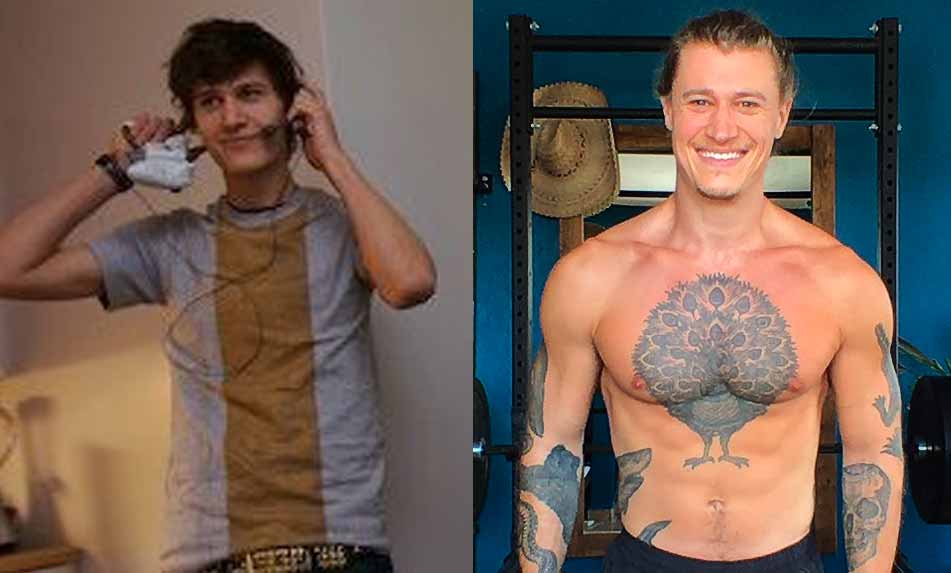
This gets a little more complicated if you’re still quite skinny, though. As you gain muscle, you’ll build bigger abs, obliques, and spinal erectors, so your waist size will increase. Back when I weighed 130 pounds, I had a waist circumference of 28 inches. Now that I’ve gained 65 pounds, my waist size went up to 32 inches, even though my body-fat percentage is still the same as when I started. So as you gain weight overall, expect your ideal measurements to increase a little bit.
Still, this gives us a rough idea of how big your forearms ought to be in proportion to your waist and biceps. That can give you an idea of whether your forearms are falling behind your biceps or not, in which case they might deserve some extra attention. When you do start training them directly, they’ll grow quite well. And the ideal forearm size isn’t unrealistic. It should be well within your grasp.
The 3 Best Forearm Exercises
One of the mistakes people make is thinking that developing a stronger grip will build bigger forearms. Your grip muscles are indeed located in your forearms. But those muscles are tiny, so making them stronger won’t do much to increase your forearm circumference.
To build bigger forearms, there are three different muscle groups we’re interested in:

- Wrist extensors: these are the muscles that run along the entire backside of your forearms. They aren’t huge muscles, and they can only grow so strong, but unless you work a manual labour job, they’re probably underdeveloped. By bulking them up, you can make the entire length of your forearms, from your elbows to your wrists, look more muscular.
- Wrist flexors: these muscles are the biceps of your forearms. They’re strong muscles with full bellies and great growth potential. Bulking these up is one of the easiest and most effective ways to increase your forearm circumference.
- Elbow flexors: these are the muscles we train with barbell rows, pull-ups, and reverse curls. You can bulk these up simply by getting stronger at the big compound lifts, but they’ll grow even faster if you train them directly.
That gives us 3 forearm exercises that we can use to bulk up all of the biggest muscles in our forearms. As we get stronger at these lifts, either by adding weight or eking out more repetitions per set, our forearms will grow steadily bigger.
Reverse Curls
The next part of building bigger forearms is training the brachioradialis muscles. People who train for strength generally do just fine here by including plenty of strapless barbell rowing in their routines. However, depending on which muscles are their limiting factors, they may still benefit from including some isolation lifts now and then.
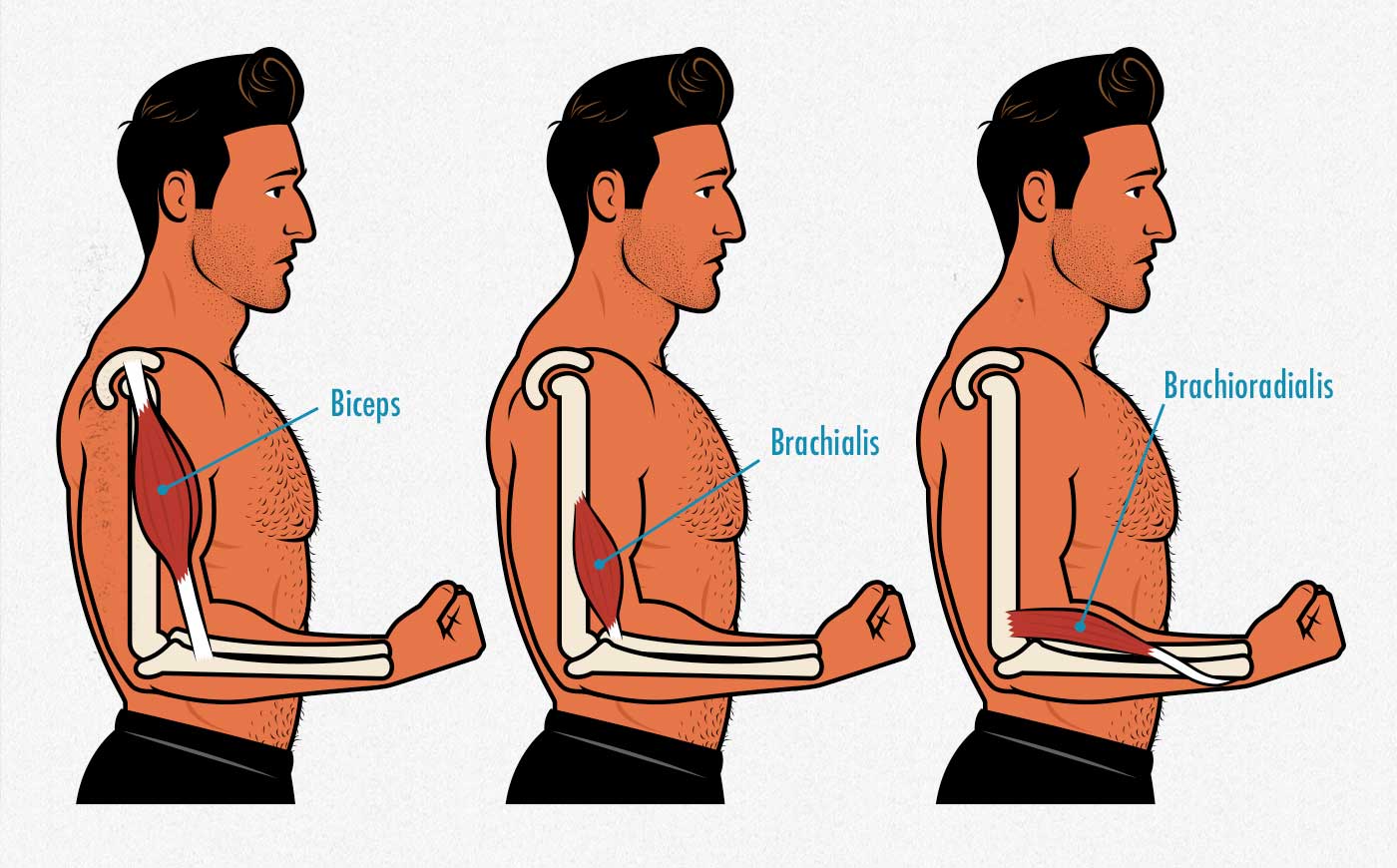
If we look at our elbow flexors, we see that our biceps, brachialis, and brachioradialis muscles can help flex our arms. If you look at how they attach to our forearms, though, you’ll notice something interesting. The muscles in our upper arms—the biceps and brachialis—both have a good pull angle when our hands are facing upwards (as in the biceps curl and underhand chin-up). In contrast, our brachioradialis muscles twist around to the back, giving us a better line of pull if we use an overhand grip. As a result, the best way to isolate our brachioradialis muscles is to do reverse curls, like so:

The reverse curl is best done with a curl-bar (aka EZ-Bar), like so:

Most gyms will have a few of these, often with fixed weights. Even if you use a home gym, these are a good barbell to invest in. They’re great for rows, curls, triceps extensions, and pullovers. But if you don’t have a curl-bar, you can always use dumbbells instead.
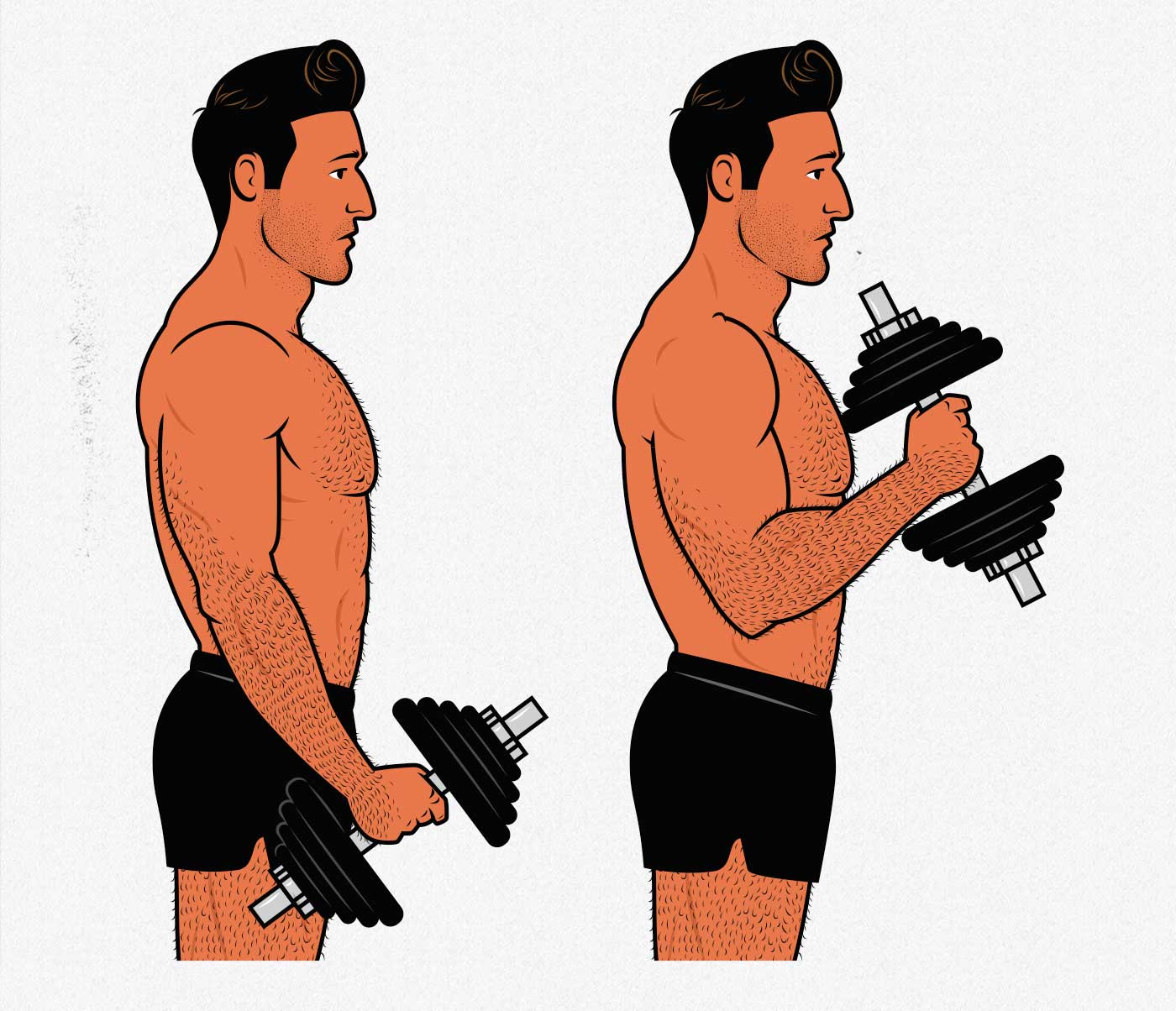
If the reverse curl makes your elbows or forearms hurt, no problem, that’s a common issue—try hammer curls instead. Hammer curls use a mix of your brachialis and brachioradialis muscles, but they still do a good job of preventing your biceps from dominating the lift.
Wrist Curls
Wrist curls are the single best exercise for building bigger forearms. Your wrist flexors have great growth potential, and building them bigger can add inches to your forearms. They’re stimulated decently well with barbell curls, but to see a robust amount of growth, it can help to target them directly with wrist curls.
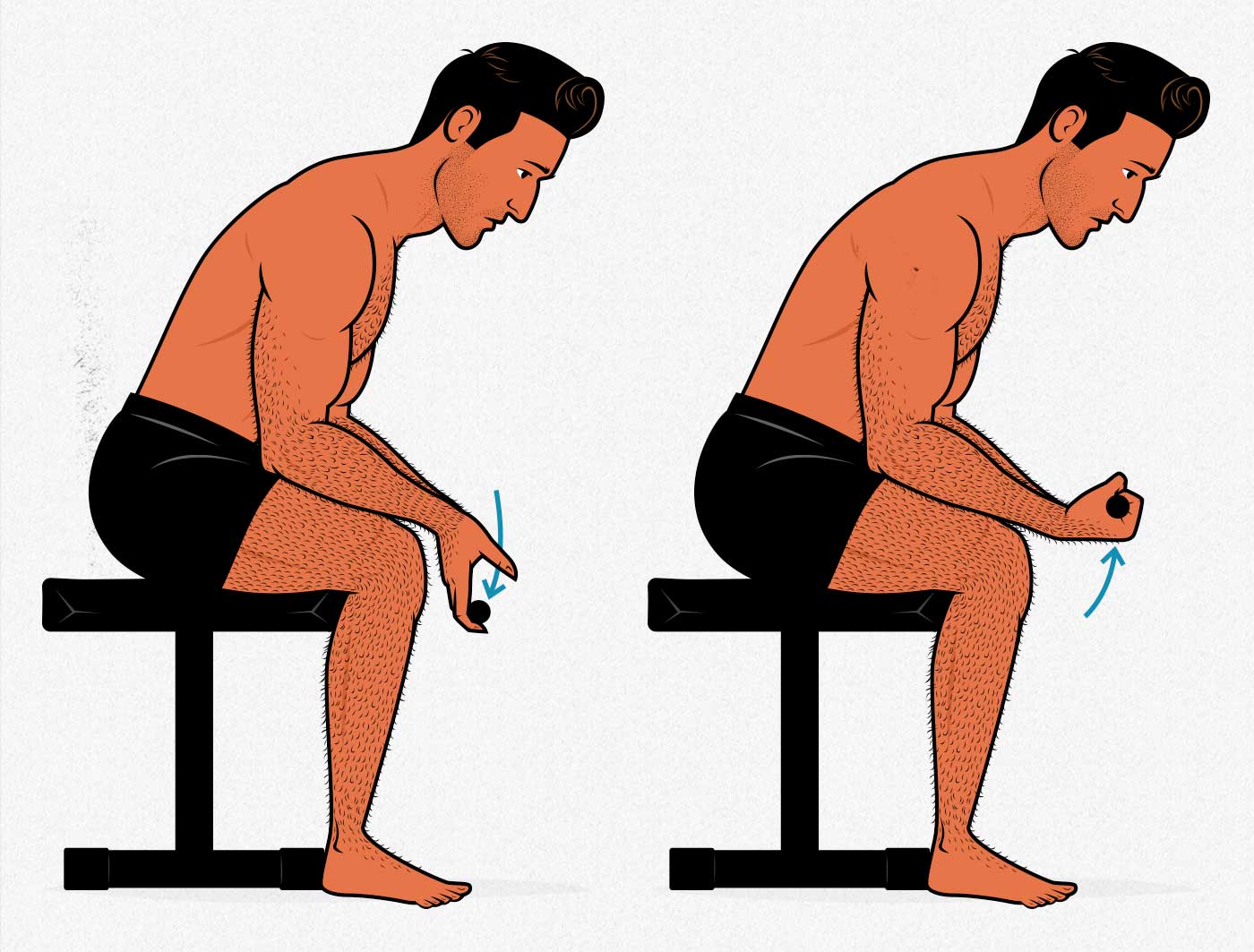
There are a couple of popular ways of doing wrist curls, but a good way to challenge them with a deep stretch and work them through a large range of motion is to use the seated wrist curl. And when doing the seated wrist curl, let the barbell roll down into your fingers, like so:
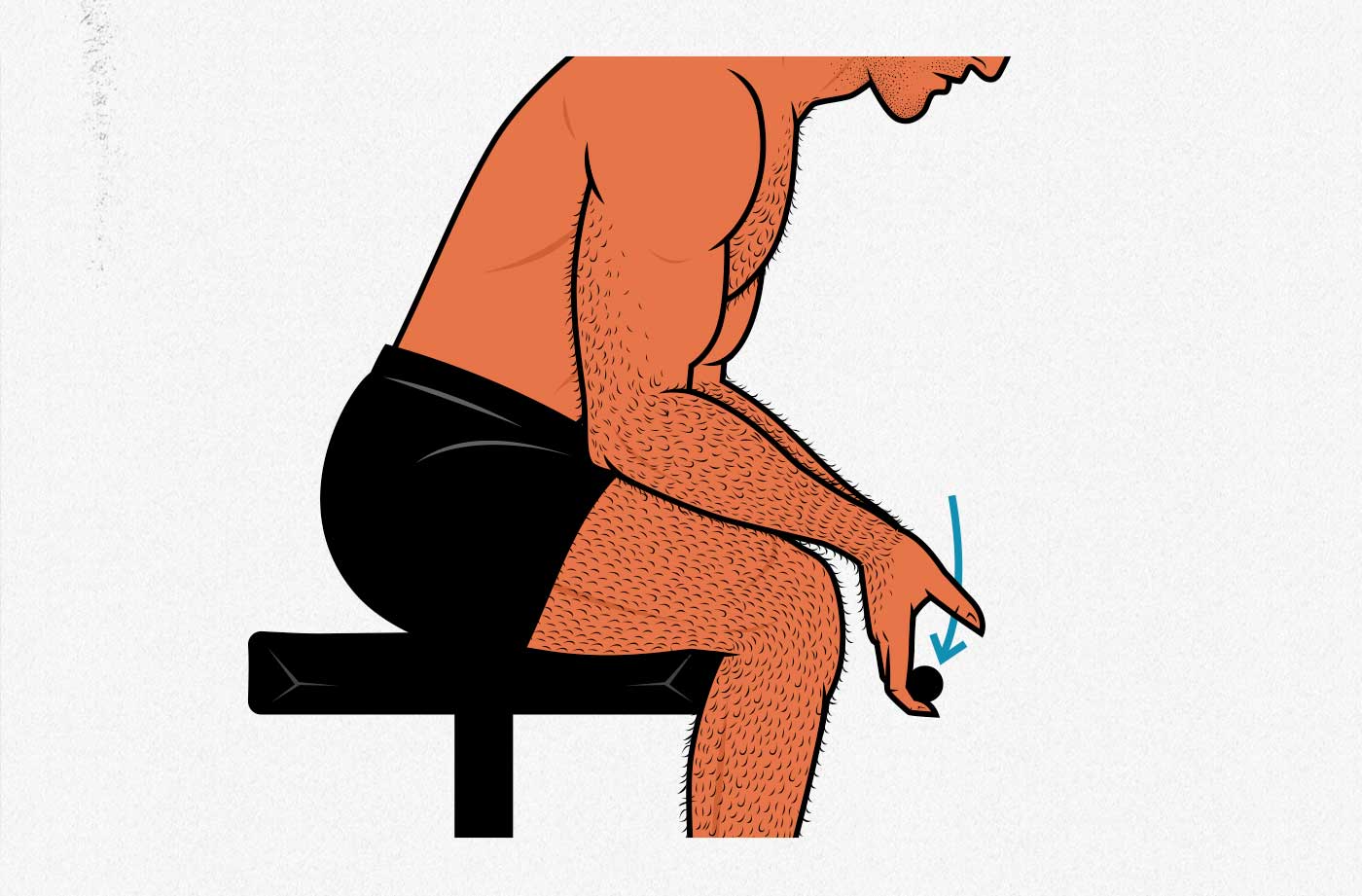
Many of our forearm flexors attach at the tips of our fingers, so by opening up our hands and then curling the weight back up with our fingers, we’re working them through a deeper range of motion. You’ll notice that if you do this, you’ll feel a much deeper stretch, get a much bigger pump, and get quite a bit more muscle growth out of your forearm curls.
Wrist Extensions
Wrist extensions are the best exercise for building bigger wrist extensors. Now, not everyone thinks this exercise is important. And to be fair. It’s not. It’s not so different from doing calf extensions in an attempt to bulk up the fronts of your shins. Is that something most people do? Nope.
Here’s the thing. If you have skinny forearms, they’re probably skinny from your wrists all the way up to your elbows. Most forearm exercises are good for training your forearms up near the elbows. That’s what barbell rows, reverse curls, and wrist curls will do. But they won’t make your wrists look thicker. And if you’re like me, with forearms that are 17 feet long, they won’t do much to bulk up the entire length of them.
That’s where wrist extensions come in. Our wrist extensors run along the entire backside of your forearms, adding girth along their entire length, right up to your wrists. These muscles aren’t big, and they won’t grow a tremendous amount, but since they span the length of your entire forearms, they can still improve the aesthetics of your forearms, making them look thicker overall.
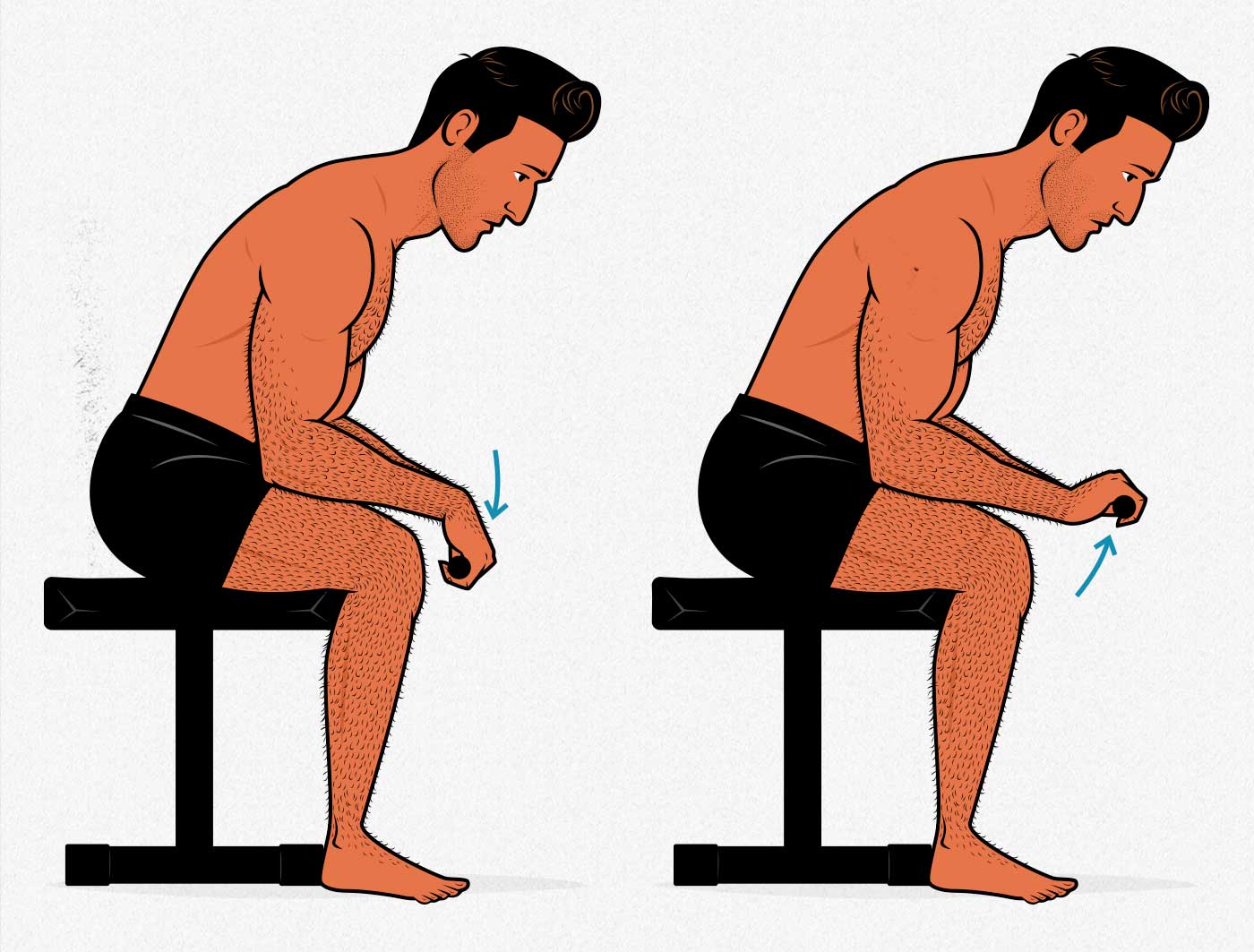
You can do forearm extensions with a barbell or curl-bar, but it might be a bit heavy, especially for your thumb. You might need to start with the pink dumbbells or by holding some 5-pound weight plates, especially if you’re doing them for 15–30 reps.
The Two Forearm Workouts
There are two levels of forearm workouts. Level 1 is the minimalist approach, and it involves relying on compound lifts for forearm growth. It’s enough for a beginner to make steady progress, and it’s enough to maintain your forearm size once you’ve bulked them up. Level 2 is when you want to speed up your forearm growth by doing dedicated forearm training.
Forearm Workout: Level 1
As a skinny beginner, you can train your forearms with compound lifts. Rows will work your brachioradialis, biceps curls will work your wrist flexors, and lateral raises will work your wrist extensors. Now, are these lifts ideal for training your forearms? No. Your forearms are unlikely to be the limiting factor, they aren’t being worked through a large range of motion, and they aren’t being trained in a deep stretch. But since you’re a beginner, it’s not hard to provoke growth. It will be enough for now.
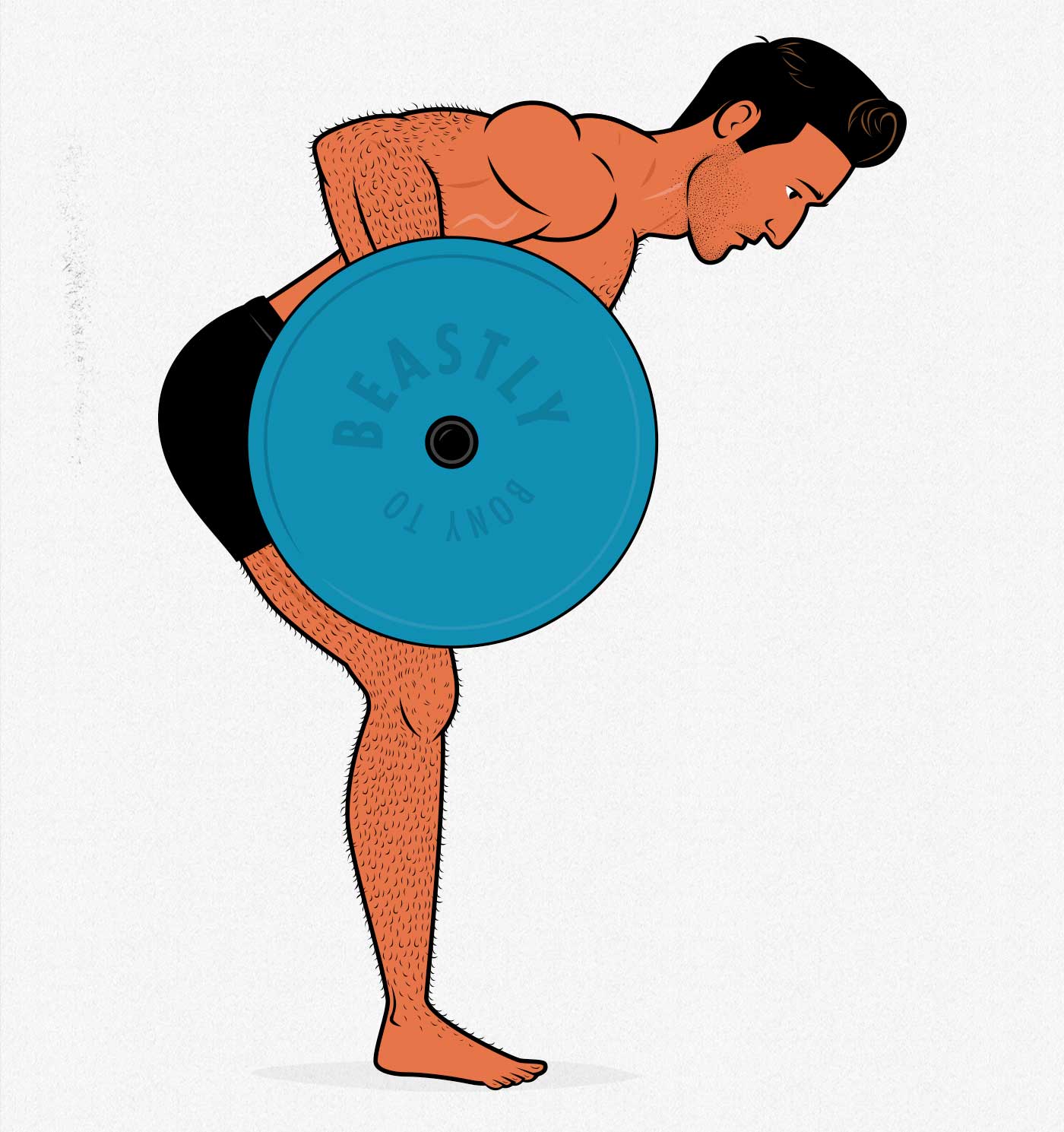
Plus, when you’re new to lifting weights, your hands can get pretty beat up. You aren’t used to holding dumbbells and barbells. They aren’t calloused yet. And so, if you start doing forearm isolation workouts, your grip and forearms might get so tired and sore that they limit your performance on the compound lifts, limiting your overall muscle growth. As a beginner, focus on getting stronger at the row, curl, and lateral raise.
A minimalist forearm workout looks like this:
- Barbell row: to bulk up your brachioradialis.
- Barbell curl: to bulk up your wrist flexors (isometrically)
- Lateral raise: to bulk up your wrist extensors (isometrically)
The next thing to remember is that maintaining muscle mass is much easier than building it. Once you’ve built bigger forearms with isolation lifts, you can maintain them with compound lifts. So spend a couple of months bulking up your forearms with isolation lifts, gain some size, and then cut them back out of your workouts, freeing up time and energy for other goals.
As a beginner, the bigger lifts are enough to build bigger forearms. Then, as a more experienced lifter, the bigger lifts are enough to maintain your forearm size and to make slow progress.
Forearm Workout: Level 2
After your first few months of training, you can radically accelerate your forearm growth by training them directly. You don’t need to do these workouts forever, just for a month or three. Then take a break, work on other goals, and focus on them again later if you need to.
Forearm workouts are fairly simple, and since your forearm muscles are relatively small, they won’t tax our cardiovascular system. As a result, they respond quite well to higher repetition and shorter rest times. That means that you can blast through an entire forearm workout in just 10–15 minutes, either on rest days or at the end of your regular workouts.
Here’s a short workout designed for maximal forearm growth:
- Reverse Curls: 2–3 sets of 10–15 reps.
- Seated Wrist Curls: 2–4 sets of 12–20 reps
- Seated Wrist Extensions: 2–3 sets of 15–30 reps
Take every set within a rep or so of muscle failure. It will burn with the fury of a fiery hell and give you a huge forearm pump. Every workout, try to eke out more reps or add a little bit more weight. If you’re new to training your forearms, expect rapid strength, both because your technique is improving and because you’re making newbie gains in your forearms.
Do this forearm workout 2–3 times per week, and do it for a minimum of 4 weeks, otherwise it might be hard to make lasting progress. And if you want to make your forearms significantly bigger, I’d recommend doing these workouts for 12 weeks. Feel free to swap in standing forearm curls and extensions, and maybe switch from reverse curls to hammer curls, or vice versa. That way you’re introducing some variety.
After training your forearms for 4–12 weeks, take a break for a month or ten, maintaining your forearm size with the bigger lifts. This will give your joints a break, and it should, in theory, re-sensitize your forearm muscles to dedicated forearm training.
As an intermediate lifter, you can build bigger forearms by training them directly. These dedicated forearm workouts will help you bulk them up quickly over the next 4–12 weeks. After that, you can maintain your forearm gains with compound lifts.
So, How Do You Build Bigger Forearms?
It’s common for skinny guys to have skinny forearms. Fortunately, there are plenty of common lifts that work our forearms at least a little bit, including rows, biceps curls, and lateral raises. As a beginner, that may even be enough for you to start gaining some forearm size.
But we can do much, much better than that. The best way to get bigger forearms is to train them directly, with forearm isolation lifts. So after you’ve gained your first 10–20 pounds of muscle, you can think about doing a couple of short forearm workouts every week. These workouts are simple and effective, and it’s realistic to gain a noticeable amount of size within just a couple of months.
- Reverse Curls: 2–3 sets of 10–15 reps to bulk up your brachioradialis.
- Seated Wrist Curls: 2–4 sets of 12–20 reps to bulk up your forearm flexors.
- Seated Wrist Extensions: 2–3 sets of 15–30 reps to bulk up your forearm extensors.
Ideally, you’d do these workout 2–3 times per week. You can do them on rest days, or you could tack them onto the ends of your regular workouts. The lifts are all simple, and although your forearms will burn with sadistic hellfire, they aren’t overly tiring, and they aren’t hard to recover from.

And, as always, if you want a full muscle-building routine, including a guide that covers everything you need to know about training, diet, and lifestyle, check out our Bony to Beastly Bulking Program (for skinny guys) or our Outlift Intermediate Bulking Program (for intermediate lifters). If you like our articles, you’d love our full programs.

